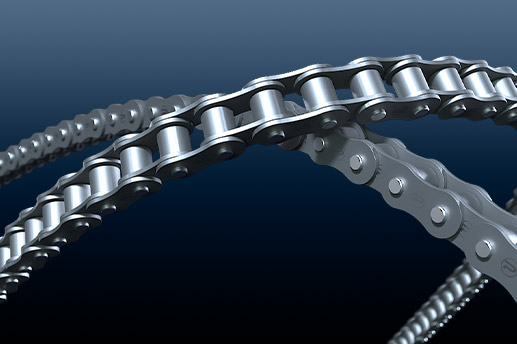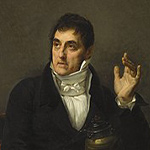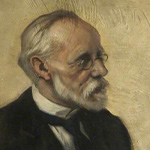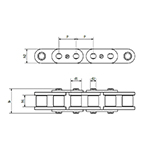The History of Roller Chain

From marine to energy to food processing, there is no industry that is a stranger to industrial roller chain.
But what is the history of roller chain, and how did this type of power transmission become so popular?
In this article, we're going to take you through the chain’s history, including came about and what made it grow in popularity, into what it is today.
When was chain first used?
The earliest recorded mention of chain was in 225BC, by Philo of Byzantium, who was a Greek engineer who wrote about mechanics. This Greek engineer was also known as Philo Mechanicus, and he pioneered many early engineering concepts. For example, it was Philo of Byzantium that described the first ever water mill.
Philo of Byzantium also described the first ever use of a chain drive. This chain drive was fitted within a repeating crossbow. This crossbow featured two flat-linked chains which were connected to a windlass. This mechanism would wind back and forth to automatically fire arrows repeatedly.
Who else was involved in the invention of chain?
Since the earliest mention of chain in 225BC by Philo Byzentium, many other early engineers contributed to the design of the roller chain as we know it today. Here are some of the people that helped to shape it into the versatile and valuable component that it is today.
Leonardo da Vinci
 Leonardo da Vinci is known for his conceptual sketches which were well ahead of his time. This includes the helicopter, solar power, parachutes and calculator. However, there is also a chance that da Vinci contributed to the invention of industrial chain.
Leonardo da Vinci is known for his conceptual sketches which were well ahead of his time. This includes the helicopter, solar power, parachutes and calculator. However, there is also a chance that da Vinci contributed to the invention of industrial chain.
In the early 1500s, Leonardo da Vinci created sketches that appear to show the first ever steel chain. This chain consisted of plates and pins, which would have been suitable for lifting applications. These sketches also show a toothed wheel driving the chain, demonstrating the depth of understanding that da Vinci had.
However, there is no evidence that these designs were ever created, so they may well have stayed in da Vinci's imagination and as paper designs until many years later.
James Fussell
It wasn't until 1800 that James Fussell patented the first roller chain, as part of a balance lock that would transport canal boats up and down a hill.
Unfortunately, his efforts ultimately failed as the project was abandoned for financial reasons. However, the design of the chain was developed from this point and would later become a pivotal component within the power transmission industry.
Andre Galle
 Andre Galle is best known as an engraver, who created some of the world's finest coins and medals. However, in 1829, Galle patented the design of the world's first leaf chain. Galle leaf chains can still be found in many heavy duty applications which operate at low speeds, including furnace doors and sluice gates.
Andre Galle is best known as an engraver, who created some of the world's finest coins and medals. However, in 1829, Galle patented the design of the world's first leaf chain. Galle leaf chains can still be found in many heavy duty applications which operate at low speeds, including furnace doors and sluice gates.
James Slater
Until this point, no one had thought to add rollers to transmission chain. However, James Slater took on the challenge and pioneered the first transmission chain containing rollers in 1864. This helped the chain to engage with the sprocket, but did not solve the problem that engineers were having with the rapid wear of chain.
Hans Renold
 In 1873, a young Swiss engineer by the name of Hans Renold came to Manchester in search of work. He began working for a machine export company, where he remained for six years. In 1879, Hans Renold purchased a textile chain business in Salford and began working on a new type of chain that would transform industry forever.
In 1873, a young Swiss engineer by the name of Hans Renold came to Manchester in search of work. He began working for a machine export company, where he remained for six years. In 1879, Hans Renold purchased a textile chain business in Salford and began working on a new type of chain that would transform industry forever.
It was a year later, in 1880, that the bush roller chain was finally invented. This was a huge development in industrial chain, which at the time was based on a pin and link model. This new design meant that chain quickly became more precise and more reliable than ever before and the business went from strength to strength.
If you spend any time researching industrial chain today, you're likely to come across the Renold name. Not only was this the company that once created bush roller chain, but it is still in operation today, manufacturing high quality chain for every industry.
So who invented it?

So, who was it that actually invented roller chain as we know it today?
This is a question that is strongly debated in the industry, as different people answer this question in different ways.
You could say that Leonardo da Vinci invented it, with his intricate sketches of the component back in the early 16th century. However, there is no evidence that these designs were ever brought to life.
Many people consider Hans Renold to be the inventor, as it was Renold who created the first ever bush roller chain and transformed the industry into what we know today.
Whoever you credit with the invention, it's obvious that there were many different people throughout history who contributed..
From Philo of Byzantium's repeating crossbow in 225BC right through to Hans Renold's addition of the bush, the invention of roller chain is something that many different engineers contributed to and should be celebrated by all who use it today.
Where is it used today?

Roller chains are the most commonly used type of industrial chain, which is why you will find this power transmission component in every industry. They are available in different sizes, lengths, and materials, enabling them to be used in almost every application and operating condition.
Here are just a few of the industries where they are used:
-
Car production
-
Marine engineering
-
Mining and excavation
-
Industrial applications and equipment
-
Food production
Get your chains from the industry experts
Industrial roller chain is arguably the most common and versatile of all power transmission components. That's why you'll find them used across every industry, in every country of the world.
If you're looking for quality roller chain for your power transmission application, our Acorn Industrial Services power transmission experts are on hand to offer advice and assistance. Contact us today to find the perfect roller chain for your application.
If you know what you need, you can also buy roller chains directly, and we may even be able to dispatch them for delivery today.
